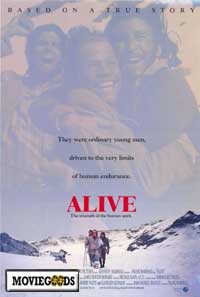


Survival cannibalism was made famous by the film Alive, which was based on the 1972 airplane crash where members of the Uruguayan rugby team and their families crashed in the Andes Mountains. Thirteen people died immediately and many more died over the weeks due to crash-related injuries. Without any food, the remaining survivors resorted to cannibalizing the dead. Those who refused to eat the human flesh died of starvation. After seventy days in the mountains, sixteen survivors were rescued and taken home.
Armin Meiwes is a German who advertised on websites for "young, well-built man aged 18 to 30 to slaughter" and actually had a reply. Bernd-Jurgen Brandes agreed to be killed and eaten by Meiwes. Meiwes was not charged with cannibalism, which is legal in a number of countries, but with 'murder for sexual satisfaction' and was sentenced to eight years in prison.
In the 1800s in the state of Colorado, a man named Alfred Packer was accused of killing and eating his traveling companions. His tale has generated much controversy over the years because some believe that he killed and cannibalized five men for his own profit while others insist he was innocent of murder and merely ate his companion's flesh to survive. Packer maintained his innocence throughout his life, but modern forensic evidence indicated that the did, in fact murder and eat several of his companions. Packer and his companions were seeking gold, and set out with a 10 day supply of food for a 75 mile trip in the snow filled San Juan Mountains. Two months passed and noone heard of the party of gold miners that had set out to make their fortunes, until Packer arrived at the Los Pinos Indian Agency with wallets in his possession that were not his. He claimed that he'd hurt his leg and fallen behind, and was unsure of where the others were. Then an Indian guide walking along the trail found strips of meat that turned out to be human flesh. Packer had killed the other men, survived off of their meat and stole their possessions.
The Donner Party was a group of 87 California-bound American settlers in the 1840s who became snowbound in the Sierra Nevadas. After running out of food, they resorted to cannibalism. Fourty-one people died, and about half of the survivors had been compelled to resort to cannibalism. The survivors were eventually rescued and returned to civilization, only to be regarded as monstrous criminals and tried for their actions. However, in the U.S., cannibalism itself is not a crime, so no legal action was ever taken.
Hans Staden was a sailor who became shipwrecked while on a Spanish expedition to Brazil in 1552. The young sailor soon found himself in the land of the Tupinambas, known throughout Europe as being savage cannibals. Staden was captured by the Tupinambas but was able to talk his way out of death by claiming he was French. He had discovered that the Tupinambas hated the Spanish and Portuguese for years of senseless war, and knew that the Tupinamba chief would spare him if he was able to prove that he was not Spanish. In 1557 Staden was rescued and returned to Europe where he compiled a narrative of his capture as well as graphic woodcuts depicting cannibalism and other elements of Tupinamba life. These woodcuts in his narrative The Captivity of Hans Staden of Hesse, in A.D. 1547-1555, were significant in that they were the earliest published images based on actual interactions with Native Americans.